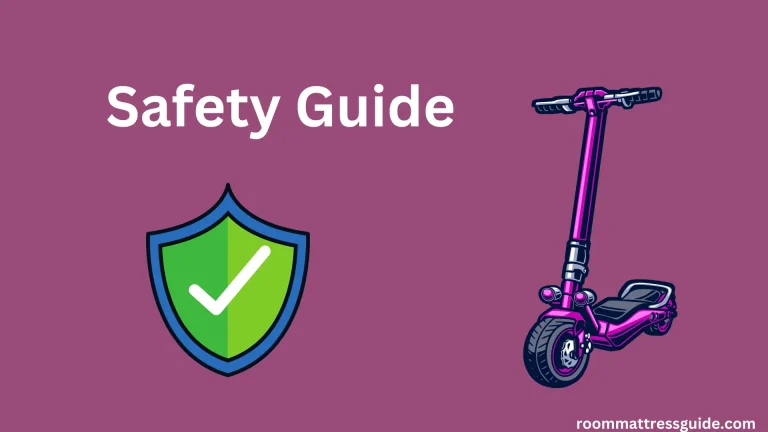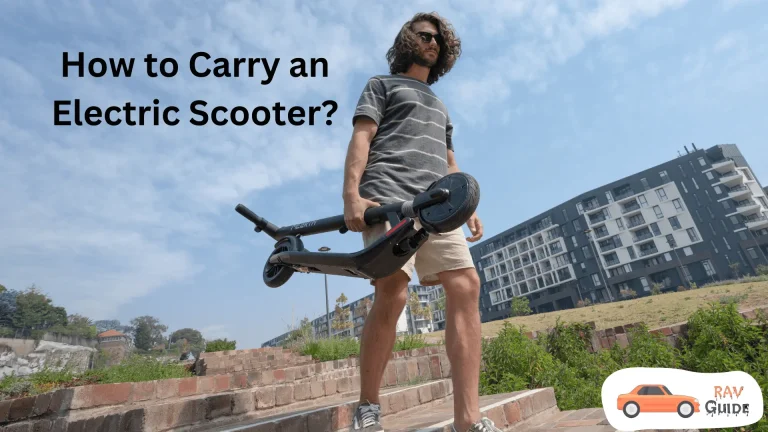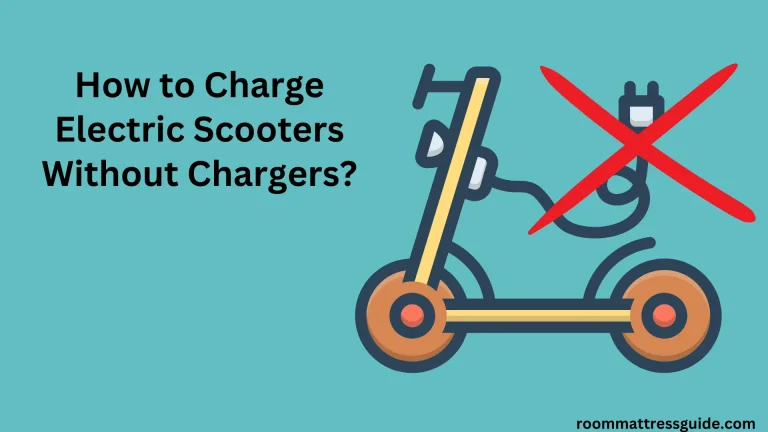Can You Ride an Electric Scooter in Winter?

Summer brings joy to electric scooter riders as they glide through the streets, but when winter arrives, the game changes. Snow covers the roads, making them slippery and challenging to navigate. So, can you still ride your electric scooter in winter?
Winter driving is risky for everyone, including experienced motorists. The roads become slippery, making it hard for tires and brakes to grip properly. Visibility decreases, and batteries may not perform as well in the cold. All these factors can affect your scooter riding experience in the snow.
But fear not! We’ve got some tips to help you safely ride your scooter in winter conditions. Let’s dive in and make your snowy adventures smooth and enjoyable.
Can You Ride an Electric Scooter in Winter?
Riding your electric scooter in winter is doable, but it comes with some extra precautions. Before embarking on your snowy adventure, check the weather forecast and road conditions to ensure safe travels.
To prepare your scooter for winter riding, consider some maintenance measures. Applying rust-resistant coatings and protective gear can shield sensitive components from the cold and moisture, extending your scooter’s lifespan and performance in harsh conditions. Additionally, investing in coverings for key parts can help keep them protected from snow and ice buildup.
By taking these steps, you can enjoy riding your electric scooter even when the temperature drops. Just remember to stay safe and be cautious on the roads. you should also know how to replace the fuses on an electric scooter.
Does Winter Weather Affect an Electric Scooter?
Yes, winter weather can indeed affect an electric scooter. Just like any vehicle, electric scooters can face challenges when the temperature drops and snow covers the ground. Here are a few ways winter weather can impact electric scooters:
- Battery Performance: Cold temperatures can reduce the efficiency of the scooter’s battery. This means you may not get as much mileage out of a single charge in winter compared to warmer months. It’s essential to keep this in mind and plan your rides accordingly.
- Traction: Snow and ice can make roads slippery, affecting the scooter’s traction. This can make it more challenging to control the scooter, especially when accelerating, braking, or turning. It’s crucial to ride cautiously and be aware of road conditions.
- Visibility: Winter weather, such as snowfall or fog, can reduce visibility for both riders and other road users. This increases the risk of accidents, so it’s essential to use lights and reflective gear to make yourself more visible to others.
- Maintenance: Cold weather can also affect the scooter’s mechanical components. Parts like brakes, tires, and motors may not perform as well in low temperatures. Regular maintenance checks are essential to ensure everything is in working order.
Overall, while winter weather can pose challenges for electric scooter riders, with proper precautions and maintenance, you can still enjoy riding your scooter during the colder months.
How to Ride an Electric Scooter in the Winter?
Riding your electric scooter in winter requires a different approach compared to warmer seasons. Safety should be your top priority as you navigate through cold and slippery conditions. While having the right safety gear is crucial, it’s equally important to adjust your riding style to match the challenges of winter weather.
One essential tip for winter scooter riding is to slow down and be extra cautious with your movements. Avoid sudden turns or changes in direction, opting instead for a steady and controlled pace. Remember, electric scooters aren’t meant for water adventures, so steer clear of puddles and potholes whenever possible. It’s hard to gauge the depth of standing water, so it’s best to play it safe and avoid them altogether.
Winter conditions increase the risks for both drivers and scooter enthusiasts, so staying vigilant is essential. Stay mindful of the environment around you and be ready for any dangers while driving. While you can’t control other people’s actions, you can react quickly to avoid accidents and dangerous situations.
In adverse weather conditions with low visibility, don’t assume that other road users have seen you. Make eye contact with drivers to ensure they’ve acknowledged your presence before making any maneuvers. Additionally, enhance your visibility by wearing bright and reflective clothing. Consider adding reflective stickers or tape to your helmet, jacket, and footwear to further increase your visibility on the road. These simple precautions can significantly reduce the risk of accidents and keep you safe during your winter scooter rides.
Tips to Consider When Riding My Electric Scooter in Winter
Navigating snowy weather on your electric scooter requires some special considerations to ensure both your safety and the scooter’s performance. Here are some valuable tips to keep in mind:
Tip 1: Invest in Winter Tires
Regular scooter tires aren’t designed for snow, so consider switching to specialized winter tires. These tires are made with softer rubber that maintains flexibility in freezing temperatures, providing better traction on slippery roads. Alternatively, off-road tires offer enhanced grip for snowy conditions.
Tip 2: Adjust Tire Pressure
If you can’t switch to winter tires, slightly deflating your scooter’s tires can improve traction by increasing the surface area in contact with the road.
Tip 3: Dress Warm and Safe
Wear appropriate clothing to stay warm in the cold weather and invest in safety gear like helmets, knee pads, and gloves to protect yourself in case of accidents.
Tip 4: Exercise Caution
Be extra cautious when riding in winter conditions. Assume other road users may not see you and avoid risky maneuvers or speeding. Prioritize safety for yourself and others.
Tip 5: Check and Tighten Brakes
Cold weather can affect brake sensitivity, so ensure your brakes are properly adjusted and tightened to compensate for any decrease in performance.
Tip 6: Fully Charge Your Battery
Cold weather can reduce battery efficiency, so always start your ride with a fully charged battery. Store the battery indoors when not in use, and allow it to warm up before charging after a cold ride.
Tip 7: Winterize Your Scooter
Protect your scooter from moisture and freezing by using a scooter cover and applying an antifreeze solution to critical parts like batteries, tires, and engines. Clean your scooter after each winter ride to remove salt residue that can cause corrosion.
By following these tips, you can enjoy safe and smooth rides on your electric scooter even in winter weather conditions.
Performance Expectations of Electric Scooters Navigating through Snow
When you take your electric scooter out in the snow, it’s important to know what to expect in terms of performance. Here’s what you need to consider:
Battery Performance
In colder temperatures, like below -10 degrees Celsius, the lithium-ion battery in your scooter may not work as efficiently. This is because the movement of ions inside the battery slows down, leading to a decrease in overall performance. Expect the battery life to decrease by around 40% when riding in snowy conditions.
Maneuverability
Snowy conditions make maneuvers on your scooter more challenging. To stay safe, try to minimize sharp turns and sudden movements. Avoid fast maneuvers to maintain control and stability while riding in the snow.
Motor Performance
The electric scooter’s motor, usually located inside the wheels, faces increased friction in snowy conditions. This can lead to reduced performance for a couple of reasons. Firstly, the copper wires inside the motor may expand due to the cold, affecting its efficiency. Additionally, snow entering the wheels can impede the motor’s function, further reducing performance.
By understanding these factors, you can better prepare for riding your electric scooter in snowy weather and ensure a safer and more enjoyable experience.
Conclusion
In conclusion, riding an electric scooter in winter requires extra caution and preparation. By adjusting your riding style, staying vigilant, and enhancing your visibility, you can enjoy safe and enjoyable rides even in cold and slippery conditions. Remember to prioritize safety at all times and be mindful of the unique challenges that winter weather presents. With the right approach, winter scooter journeys can be both fun and safe.
FAQs
Can I use my electric scooter in the rain?
While electric scooters are generally water-resistant, riding in heavy rain or through deep puddles can damage the scooter’s electrical components. It’s best to avoid riding in heavy rain if possible.
How do I prevent my scooter from slipping on icy surfaces?
To improve traction on icy surfaces, consider installing snow tires or tire chains specifically designed for electric scooters. Additionally, riding at a slower speed and avoiding sudden movements can help prevent slipping.
What should I do if my scooter gets wet in the snow?
If your scooter gets wet in the snow, dry it off as soon as possible to prevent damage to the electrical components. You can use a towel or cloth to wipe down the scooter, paying extra attention to sensitive areas like the battery and motor.
Are there any special maintenance tips for winter riding?
During winter riding, it’s essential to regularly clean your scooter to remove salt and debris that can cause corrosion. Additionally, lubricating moving parts and checking tire pressure regularly can help maintain optimal performance in cold weather.
Can I ride my scooter in sub-zero temperatures?
While electric scooters can technically operate in sub-zero temperatures, extreme cold can affect battery performance and overall scooter functionality. It’s best to avoid riding in extremely cold temperatures if possible and store your scooter indoors when not in use.
Do I need to adjust my riding style in windy conditions?
Yes, strong winds can affect the stability of your scooter, especially on open roads or bridges. To maintain control, grip the handlebars firmly and lean slightly into the wind to counterbalance any gusts.






